The iPhone 5s Review
by Anand Lal Shimpi on September 17, 2013 9:01 PM EST- Posted in
- Smartphones
- Apple
- Mobile
- iPhone
- iPhone 5S
Display
The iPhone 5s, like the iPhone 5c, retains the same 4-inch Retina Display that was first introduced with the iPhone 5. The 4-inch 16:9 LCD display features a 1136 x 640 resolution, putting it at the low end for most flagship smartphones these days. It was clear from the get-go that a larger display wouldn’t be in the cards for the iPhone 5s. Apple has stuck to its two generation design cadence since the iPhone 3G/3GS days and it had no indication of breaking that trend now, especially with concerns of the mobile upgrade cycle slowing. Recouping investment costs on platform and industrial design are a very important part of making the business work.

Apple is quick to point out that iOS 7 does attempt to make better use of display real estate, but I can’t shake the feeling of being too cramped on the 5s. I’m not advocating that Apple go the route of some of the insanely large displays, but after using the Moto X for the past month I believe there’s a good optimization point somewhere around 4.6 - 4.7”. I firmly believe that Apple will embrace a larger display and branch the iPhone once more, but that time is just not now.
The 5s’ display remains excellent and well calibrated from the factory. In an unusual turn of events, my iPhone 5c sample came with an even better calibrated display than my 5s sample. It's a tradeoff - the 5c panel I had could go way brighter than the 5s panel, but its black levels were also higher. The contrast ratio ended up being very similar between the devices as a result. I've covered the panel lottery in relation to the MacBook Air, but it's good to remember that the same sort of multi-source components exist in mobile as well.
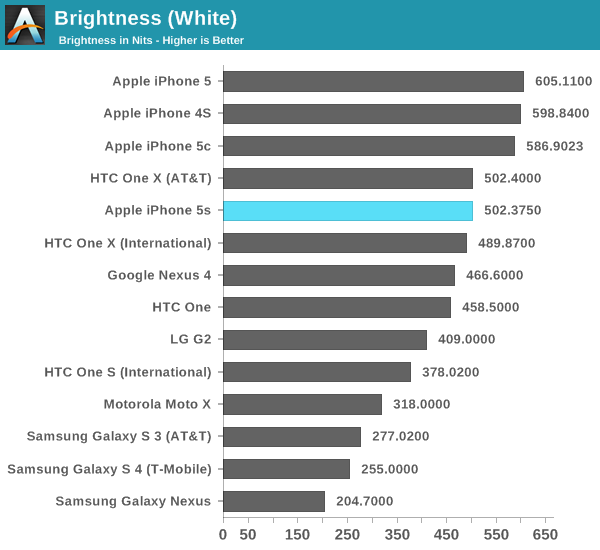
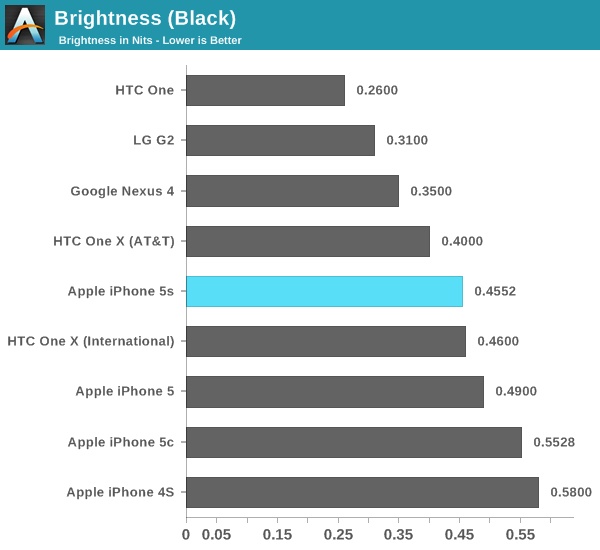
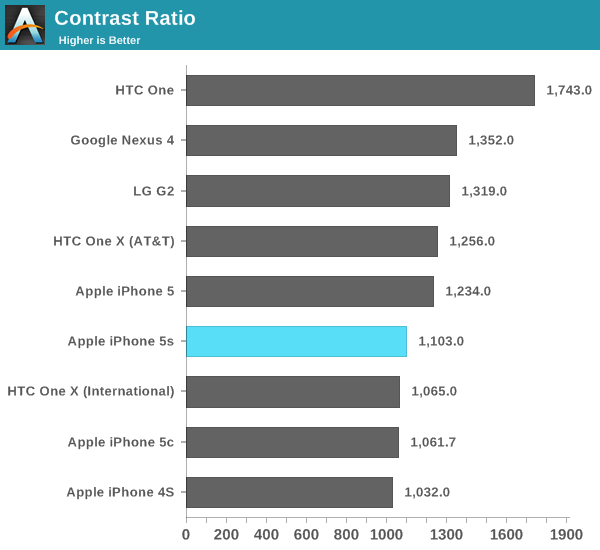
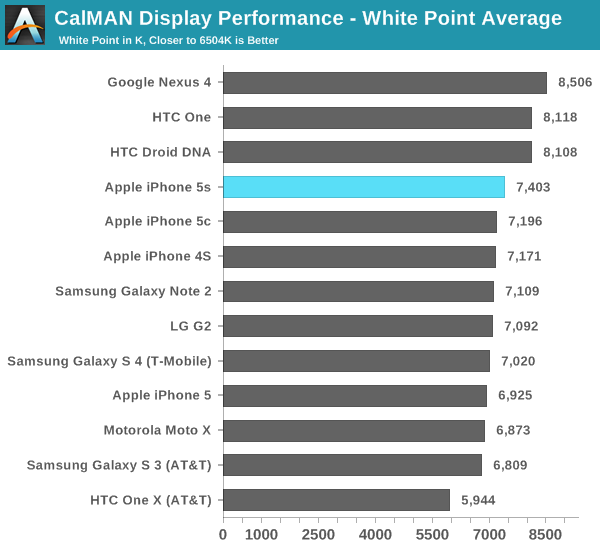

Color accuracy is still excellent just out of the box. Only my iPhone 5c sample did better than the 5s in our color accuracy tests. Grayscale accuracy wasn't as good on my 5s sample however.
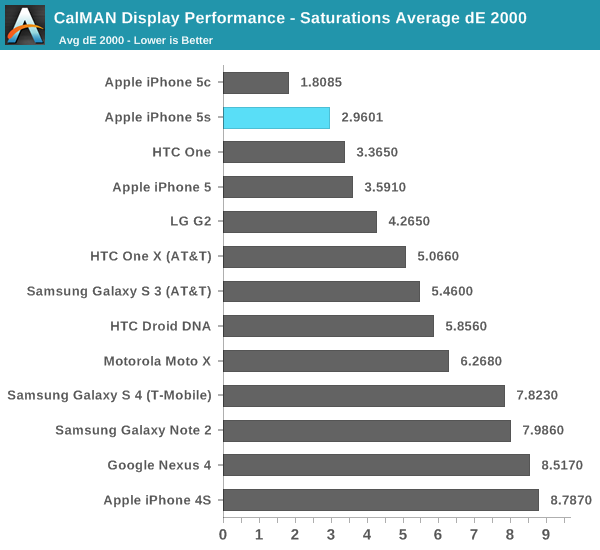
Saturations:

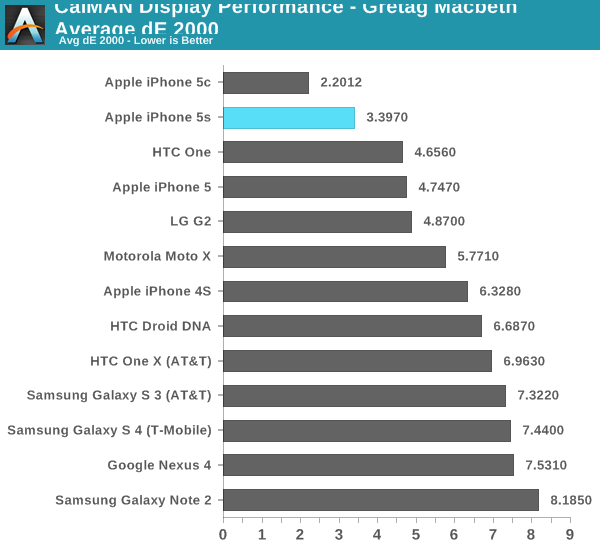
GMB Color Checker:

Cellular
When early PCB shots of the 5s leaked, I remember Brian counting solder pads on the board to figure out if Apple moved to a new Qualcomm baseband solution. Unfortunately his count came out as being the same as the existing MDM9x15 based designs, which ended up what launched. It’s unclear whether or not MDM9x25 was ready in time in order to be integrated into the iPhone 5s design, or if there was some other reason that Apple chose against implementing it here. Regardless of the why, the result is effectively the same cellular capabilities as the iPhone 5.
Apple tells us that the wireless stack in the 5c and 5s is all new, but the lack of LTE-Advanced features like carrier aggregation and Category 4 150Mbps downlink make it likely that we’re looking at a MDM9x15 derivative at best. LTE-A support isn’t an issue at launch, however as Brian mentioned on our mobile show it’s going to quickly become a much needed feature for making efficient use of spectrum and delivering data in the most power efficient way.
The first part is relatively easy to understand. Carrier aggregation gives mobile network operators the ability of combining spectrum across non-contiguous frequency bands to service an area. The resulting increase in spectrum can be used to improve performance and/or support more customers on LTE in areas with limited present day LTE spectrum.
The second part, improving power efficiency, has to do with the same principles of race to sleep that we’ve talked about for years. The faster your network connection, the quicker your modem can transact data and fall back into a lower power sleep state.
The 5s’ omission of LTE-A likely doesn’t have immediate implications, but those who hold onto their devices for a long time will have to deal with the fact that they’re buying at the tail end of a transition to a new group of technologies.
In practice I didn’t notice substantial speed differences between the iPhone 5s, 5c and the original iPhone 5. My testing period was a bit too brief to adequately characterize the device but I didn’t have any complaints. The 5s retains the same antenna configuration as the iPhone 5, complete with receive diversity. As Brian discovered after the launch, the Verizon iPhone 5s doesn’t introduce another transmit chain - so simultaneous voice and LTE still aren’t possible on that device.
Apple is proud of its support for up to 13 LTE bands on some SKUs. Despite the increase in support for LTE bands there are a lot of iPhone 5s SKUs that will be shipped worldwide:
| Apple iPhone 5S and 5C Banding | |||||||
| iPhone Model | GSM / EDGE Bands | WCDMA Bands | FDD-LTE Bands | TDD-LTE Bands | CDMA 1x / EVDO Rev A/B Bands | ||
|
5S- A1533 (GSM) |
850, 900, 1800, 1900 MHz | 850, 900, 1700/2100, 1900, 2100 MHz | 1, 2, 3, 4, 5, 8, 13, 17, 19, 20, 25 | N/A | N/A | ||
|
5S- A1533 (CDMA) |
800, 1700/2100, 1900, 2100 MHz | ||||||
|
5S- A1453 |
1, 2, 3, 4, 5, 8, 13, 17, 18, 19, 20, 25, 26 | ||||||
|
5S- A1457 5C- A1507 |
850, 900, 1900, 2100 MHz | 1, 2, 3, 5, 7, 8, 20 | N/A | ||||
|
5S- A1530 5C- A1529 |
1, 2, 3, 5, 7, 8, 20 | 38, 39, 40 | |||||
| Apple iPhone 5S/5C FCC IDs and Models | |||
| FCC ID | Model | ||
| BCG-E2642A | A1453 (5S) A1533 (5S) | ||
| BCG-E2644A | A1456 (5C) A1532 (5C) | ||
| BCG-E2643A | A1530 (5S) | ||
| BCG-E2643B | A1457 (5S) | ||
| BCG-E2694A | A1529 (5C) | ||
| BCG-E2694B | A1507 (5C) | ||
WiFi
WiFi connectivity also remains unchanged on the iPhone 5s. Dual band (2.4/5GHz) 802.11n (up to 150Mbps) is the best you’ll get out of the 5s. We expected Apple to move to 802.11ac like some of the other flagship devices we’ve seen in the Android camp, but it looks like you’ll have to wait another year for that.
I don’t believe you’re missing out on a lack of 802.11ac support today, but over the life of the iPhone 5s I do expect greater deployment of 802.11ac networks (which can bring either performance or power benefits to a mobile platform).
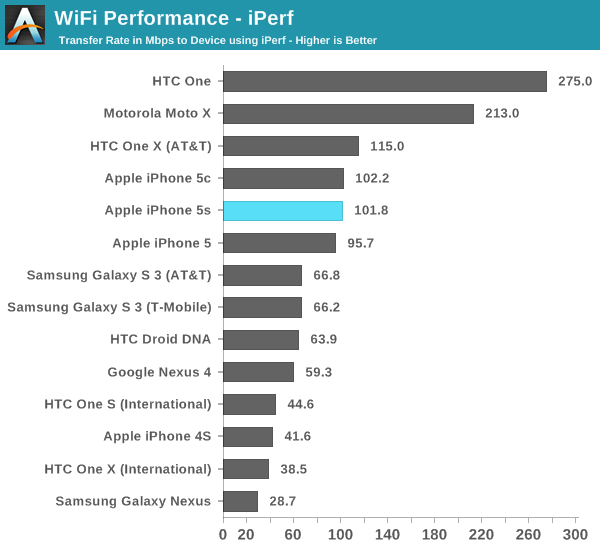
WiFi performance seems pretty comparable to the iPhone 5. The HTC One and Moto X pull ahead here as they both have 802.11ac support.













464 Comments
View All Comments
ESC2000 - Saturday, September 21, 2013 - link
So inexplicably the air has this great GPU coupled with a crappy screen that limits the GPU's impact. Then on the windows ultrabooks we have generally better screens (at least on the ones that have similar cost to the air) but less good GPUs.akdj - Tuesday, October 8, 2013 - link
Touché. I'll give ya that one. While I do love my MBA for travel, the screens suck! Point was not to compare displays----rather iGPU technology movementvcfan - Wednesday, September 18, 2013 - link
I doubt the A7X is even close to 300GFLOPStipoo - Wednesday, September 18, 2013 - link
78 times 2. It'll probably be close to 160 Gflops, if historical A*X series performance doubling is to be followed.DeciusStrabo - Wednesday, September 18, 2013 - link
Admittedly the original 11" MBA was a dog in terms of performance when it was released. Still 1/3-1/2 (depending on the benchmark) of the speed of my i3-3220 Home Server isn't exactly bad for a phone.jeffkibuule - Wednesday, September 18, 2013 - link
Didn't the original 11" MBA have overheating problems? That thing was a toaster.coolhardware - Tuesday, September 17, 2013 - link
Very nice review as always Anand :-)I especially enjoyed checking out the display closeups and charts. As you mention, Apple's display size and pixel density are both falling behind flagship phones from other manufacturers, this list http://pixensity.com/list/phone/ puts it well outside of the top 10.
However, Apple displays are generally pretty nice to look at. I cannot help but wonder if Apple is going to get any major display breakthroughs in future generations, or if other manufacturers (Samsung, LG, or other) will be able to surpass it... anyhoo, thanks for the nice review!
PS if anyone has subjective opinions after viewing the 5s' display versus other flagships, I would appreciate hearing about it!
Impulses - Tuesday, September 17, 2013 - link
It's not like Apple's designing their display in Cupertino... I'm sure they have a large degree of control in order to get the specs they need and the calibration etc, but if there's any sorta revelation in display tech it'd come from the labs of the people that actually make them (Samsung, LG, Sharp, etc).Impulses - Tuesday, September 17, 2013 - link
Oh and my subjective opinion on current flagship displays is that I'd still take an IPS/super LCD/whatever over the typical over saturated AMOLED, the Moto X made a strong case for using AMOLED for it's active notifications but ehh... I like LG's tap to wake gimmick on their recent models, and after owning two 4.3" devices and a 4.6-4.7" (all with capacitive buttons) I'm actually yearning for something a bit more compact. I think the Moto X is a near perfect fit, although it does sacrifice some screen space for the buttons... I thought on screen buttons were pointless at first because none of the early devices that used them had less bezek space nor where they smaller, but we're finally seeing that become a reality with the X and the G2 so I think I'm on board now. Die bezels die! (along with menu etc, HTC dumping the multi task button bothered me tho, one of their few design missteps IMO)coolhardware - Tuesday, September 17, 2013 - link
Thank you Impulses for the nice analysis.I too really like the Moto X. It seems like it hits the sweet spot in size/capability plus it is actually available on my carrier (US Cellular). I wish that all carriers got the Moto X customization options though because I find that to be a pretty cool feature:-)
I will eventually be replacing my Galaxy Note 2 with giant extended battery:
http://goo.gl/TxUnez
with something and right now it is a toss up between the upcoming Galaxy Note 3 and the Moto X. I really dislike how sluggish my Note 2 can be and I mainly blame that on Samsung's skin on top of Android :-( That is a big plus for the Moto X since I hear it is pretty clean in that respect.
My new choice may be Moto X + Nexus 7 FHD rather than Note 3.
Any other thoughts/opinions on the topic?